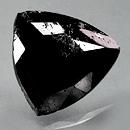|
Click on a letter above to view the list of gems. |
|
|
|
|
|
|
|
|
Molybdenite
|
|
| | |
| Discovered in 1807. IMA status: Valid (pre-IMA; Grandfathered) | ||
|
| ||
|
Chemistry |
| |||||||||||||||
|
| ||||||||||||||||
|
MoS2 | ||||||||||||||||
|
|
Molybdenum Sulfide | |||||||||||||||
|
Molecular Weight: |
160.07 gm | |||||||||||||||
|
Composition: |
| |||||||||||||||
|
|
||||||||||||||||
|
|
|
Classification |
|
|
| |
|
Sulfides | |
|
2/D.25-10 | |
|
|
2 : SULFIDES and SULFOSALTS (sulfides, selenides,
tellurides; arsenides, antimonides, bismuthides; sulfarsenites,
sulfantimonites, sulfbismuthites, etc.) |
|
Related to: |
Molybdenum Group. Dimorphous with Jordisite. Two polytypes are known: Molybdenite-2H (very common) and Molybdenite-3R (rare). |
|
Varieties: |
Femolite, Rhenian Molybdenite |
|
Synonyms: |
Castaingite-(Cu), Molybdic Ochre, Muchuanite - a mixture of Molybdenite and Jordisite |
|
|
|
|
Crystal Data |
|
|
|
|
|
Crystals are commonly tabular, barrel shaped; also as slightly tapered prisms; face development poor; up to 15 cm across. Commonly shows trigonal markings on {0001} parallel to the trace of {1011}. Foliated, massive, or in scales. |
|
|
None |
|
|
|
|
|
Physical Properties |
|
|
|
|
|
[0001] Perfect |
|
|
Sectile |
|
|
Lamellae flexible, not elastic |
|
|
1.0 |
|
|
4.62 - 4.73 (g/cm3) |
|
|
None |
|
|
Not Radioactive |
|
|
|
|
|
Optical Properties |
|
|
|
|
|
Black, lead Gray, Gray, Silvery Black with a Bluish cast |
|
|
Opaque to nearly Opaque; translucent in thin flakes; transparent in infrared light |
|
|
Metallic |
|
|
R1–R2: (400) 21.0–55.0, (420) 22.2–54.8, (440) 23.4–54.6, (460) 24.1–53.8, (480) 23.8–52.3, (500) 22.7–49.7, (520) 21.9–47.1, (540) 21.3–45.5, (560) 20.9–44.4, (580) 20.6–44.0, (600) 20.4–44.6, (620) 20.2–45.3, (640) 20.0–45.7, (660) 20.0–45.6, (680) 19.9–45.4, (700) 19.7–44.2 |
|
|
0.0140 |
|
|
Very Strong |
|
|
Very Strong; Color in reflected light: gray, very pale yellow to deep reddish brown in transmitted light. |
|
|
|
|
|
Occurances |
|
|
|
|
|
Geological Setting: |
In high-temperature hydrothermal veins. In disseminated deposits of the porphyry type, both with and without associated major copper mineralization. Also in contact metamorphic deposits in limestone with calcium silicate minerals as well as in pegmatites, granites, and aplites. Rarely in meteorites. |
|
Common Associations: |
Chalcopyrite, other copper sulfides |
|
Type Locality: |
Common world wide occurrences |
|
Year Discovered: |
1807 |
|
View mineral photos: | |
|
|
|
|
More Information |
|
|
|
|
|
| |
|
|
|
|
Molybdenite
is of widespread occurrence; the most abundant molybdenum
mineral. Fine crystals occur, in the USA, at the Crown
Point mine, Lake Chelan, Chelan County, Washington;
and at the Frankford quarry, Philadelphia, Pennsylvania.
In Canada, in the Temiskaming district, and in Aldfield
Township, Quebec. In Norway, from Raade, near Moss,
and at Vennesla, near Arendal. In Russia, in the Adun-Chilon
Mountains, south of Nerchinsk, Transbaikal; at Miass,
Ilmen Mountains, Southern Ural Mountains; and in the
Slundyanogorsk deposit, Central Ural Mountains. In Germany,
at Altenberg, Saxony. In Morocco, at Azegour, 80 km
southwest of Marrakesh. From Kingsgate and Deepwater,
New South Wales, Australia. At the Hirase mine, Gifu
Prefecture, Japan. In the Wolak mine, Danyang, Chungchong
Province, South Korea. The 3R polytype occurs in the
Con mine, Yellowknife, Yukon Territory; and at Mont
Saint-Hilaire, Quebec, Canada. From the Yamate mine,
Okayama Prefecture, Japan. |
|
|
We
have not photographed our Molybdenite gems. Please
check back soon. |
